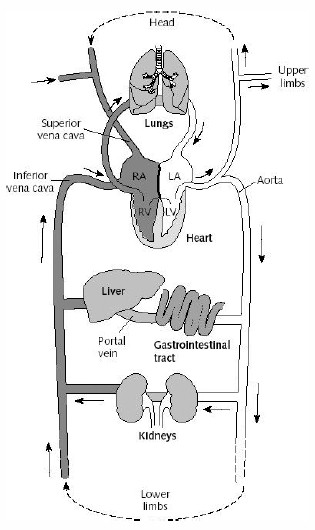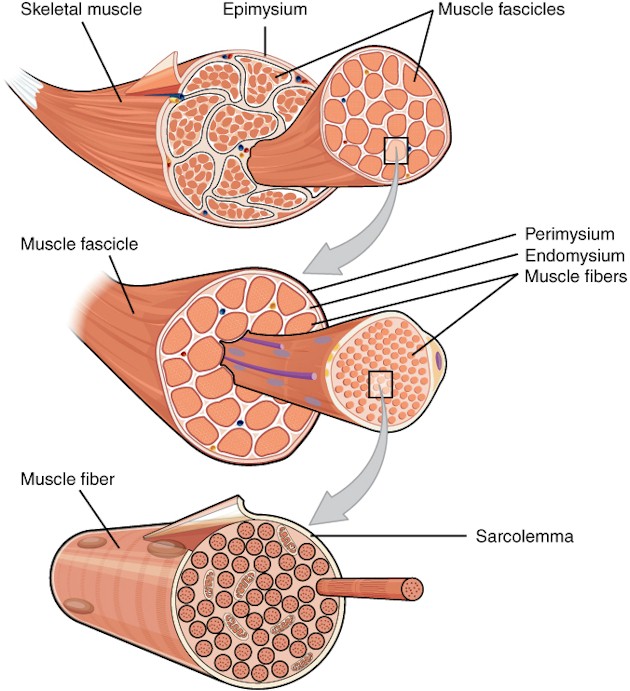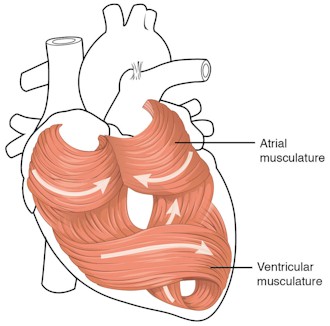Contents
Muscles—essential for movement-don’t get much thought until we feel it in the arms moving that sofa. We spend a lot more time on skin, hair and nails … making them look pretty.
We will briefly discuss skin, hair, nails and muscles. We already know the skin is our protective covering and is large enough to coat our entire body.
(chapter 8.5-6)
One of our group members, a male weighing sixty-eight kilograms (150 pounds), considers this fact: if his skin were stretched out flat, it would cover about 1.8 square meters (slightly larger than the size of a single bed) and would weigh four kilograms (nine pounds), which is the weight of a large baby!
If the skin of a 68 kg person were stretched out flat, it would cover about 1.8 square meters - slightly larger than the size of a single bed. Click To TweetAll this skin contains nerve endings and protects blood vessels, bones, muscles, and organs. We ponder how, thanks to varying amounts of melanin pigmentation, this resilient covering can be dark, olive, pink, brown, or extremely fair.
We think about the abundant oxygen that helps the growth of new cells. It makes up the sixteen trillion skin cells in each of our bodies, as well as replacing the 3.6 kilograms (eight pounds) of skin cells that we lose each year (when put together, they’d be roughly the size of a Thanksgiving turkey). We also think about the hair—blond, brown, black, straight, or frizzy—that covers our skin and scalp.
Hair, whether found on the head, arms, legs, chest, back, hands or feet, is protein. Protein is a kin of skin. Similarly, fingernails and toenails grow out of the deep skin folds in fingers and toes, and protect the skin, nerves and blood vessels underneath. Our fingernails may have some slight function in gripping, but are not made for clawing or climbing!
They are purely protective, and we ponder why humans don’t need claws (or fur, for that matter) like certain mammals do! However, we’re not so much concerned with hair, skin, and nails on their own as we are with that which is “more than skin deep”—the muscles.
Muscles: The Engine
Think of the bones as the body of a car, and the muscles as the engine. Muscles turn the energy inside your cells into motion. Muscle tissue makes up 36 percent of an adult female’s body and 42 percent of an adult male’s.
All the muscles (roughly 650 to 800 in number) in our face, shoulders, back, arms, core/trunk, and legs work every day, every hour, every second—even when we are asleep and there is technically no “work” going on.
When we’re healthy, our skeletal muscles, which attach to our bones and connect joints, work so well that we can conduct our days by raising our arms to stretch in the morning, driving, walking, getting on the train, rocking a child to sleep, and even reading a story.
Facial muscles do the work of presenting a smile to the world and showing emotion. There are forty-three muscles in the face, which are controlled by five branches of the facial nerve. These make the face form the full range of expressions, from happiness to anger. Without the muscles of the tongue, mouth, and larynx, we could not form the word “hello.”
Facial muscles do the work of presenting a smile to the world and showing emotion. These make the face form the full range of expressions, from happiness to anger. Click To TweetWe do all these things, often with intense thought, sometimes not, but our muscles make it possible for us to do the activities of daily living. When our bodies work well day after day, year after year, we don’t even think about the muscles that move unless we are competing in an athletic event or lifting weights at the gym.
Our thought is even provoked by the muscles involved when a group member lifts a spoonful of cereal to his mouth and balances the bowl in the other hand for demonstration purposes. The simple muscle movements involved in using utensils to eat breakfast go unnoticed during our daily lives (more on this later). As we’ve said, even smiling takes muscles.
Apart from the facial muscles, there are eleven major muscle groups in the body, each group with its own specialization.
Listed from head to toe, they are shoulder muscles, which we flex as we raise our arms; trapezius muscles in the upper back, which we tense as we perform a deadlift; the rest of the back muscles, which are involved in posture and demanding physical work; the chest muscles that protect us as well as looking attractive on men and women; the triceps, which make up two-thirds of the upper arm; the biceps and the forearms, which are all important in arm strength; the quadriceps at the front of the thigh, which aid in walking and moving; the abdominals, which are important for balance and a solid core; the hamstrings on the back of the thighs, which strengthen and stretch to prevent injury; and the calf muscles, which get strengthened through leg exercises.
This is especially true for people in occupations that require them to be on their feet all day. There is also muscle tissue in your hands. All of these muscle groups are what we call skeletal muscles. They work to make body language, running, jumping, and dancing possible. The doctors talk about these.
We also have smooth muscle tissue, which makes up our organs. We realize that this is especially significant when we think about our breath and our lungs. We again think of oxygen
and the importance of its flow to the major organs and the skeletal muscles as well as its circulation throughout the body.

The body functions thanks to the fine-tuned 24/7/365 involuntary workings of the circulatory and respiratory systems
As we see in a diagram of the heart, the cardiac muscle pumps oxygen-rich blood. Consider this fact: The cardiac muscle is found only in the heart, which keeps us alive.
We think about the way that these muscle groups interact. The tongue, mouth, and digestive muscles (smooth tissue) involved in eating provide energy to the cells and lungs (smooth tissue).
This transfers oxygen to the blood, and the cardiac tissue pumps the oxygen so that it can be conducted to the skeletal muscles, thereby enabling us to move. As we move, we expand our lung capacity and strengthen our muscles (including the cardiac muscle).
We also breathe in, which provides more oxygen for our blood.
Consider that these three groups of muscle work in perfect concert, and that all three contract constantly and invisibly thanks to the muscles fibers and signals sent by neurotransmitters in the nervous system, which are made up of amino acids and peptides and are crafted in the cells.
This protein is produced by cells and coded for by DNA filaments to do the work of contracting the muscles. This means that the doctors can reach for an IV bag, for example.
We ponder once again that the ingredients of life we saw in the lab in the previous chapter can make up all of the bones, muscles, and organs we have been introduced to.
We are drawn to the doctors’ hands. As we’ve seen in our tour, these hands perform a wide variety of tasks, including detailed surgery. Indeed, hands are one of the human body’s
most noteworthy features.
This post is an excerpt from chapter 8.5-6 of Inventory of the Universe.
The Explanation Blog Bonus:
Today I’m focusing on the heart muscle, most of us don’t think of the heart as such, but it is obviously one of the most important muscles of the body. The cardiac muscle pattern is elegant and complex as the images will attest. Consider their pattern, consider their strength of ‘cords inside cords’ (2nd image below) and finally marvel at the 3D presentation realizing that your heart will pump enough blood to fill about 150 cars everyDAY, with over 3 billion contraction over an 80 year period. That’s some muscle!
The middle layer (of 3 layers) of the heart wall is the myocardium, is the cardiac muscle. The muscle cells swirl and spiral around the chambers of the heart:
>> The outer muscles form a figure 8 pattern around the atria and around the bases of the great vessels
>> The inner muscles form a figure 8 around the two ventricles and proceed toward the apex. This complex swirling pattern allows the heart to pump blood more effectively.
This next image reveals the elegant and simple combination of strands to form the strong bond that contracts and lengthens second after second, minute after minute, hour after hour, day after day, week after week, month after month, year after year … for an entire lifetime … automatically … to maintain our lives and allow us freedom of movement. The human body is a wondrous thing.

Muscle makeup … notice the muscle strands inside a second strand of muscles inside a third strand of muscles. It reminds me of the metal cords used to hold up suspended bridges … except the latter are solely for strength; they don’t contract day in and day out.
Dig Deeper into The Explanation
Join The Explanation Newsletter to stay informed of updates. and future events. No obligations, total privacy, unsubscribe anytime, if you want.
Online Study Courses to Unlock Bible meaning via Biblical Hebrew… with no fuss. Free video courses that put you in the driver’s seat to navigate the Bible as never before. Join now
The Explanation series of seven books. Free to read online or purchase these valuable commentaries on Genesis 1-3 from your favorite book outlet. E-book and paperback formats are available. Use this link to see the details of each book and buy from your favorite store.
Since you read all the way to here… you liked it. Please use the Social Network links just below to share this information from The Explanation, Muscles on the Inside, Skin, Hair, and Nails on the Outside … Key Body Parts



